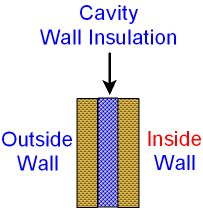
gcsescience.com 14 gcsescience.com
How is Trapped Air used for Heat Insulation in Buildings?
Trapped air can be used in various ways to insulate buildings.
Examples are loft insulation, hot
water tank and
pipe
insulation,
double glazing and cavity wall
insulation (see below).
How does Cavity Wall Insulation Work?
Many
houses are built with cavity
walls.
There is an
outside wall and an
inside wall with an air
gap between the
two walls. This is a good way of preventing the inside
wall
of the house from becoming damp
but the air gap
can transfer heat by convection making the house colder.
Cavity wall
insulation fills the air gap with a polymer foam.
The foam is a type of plastic material that has air trapped inside
it.
The foam replaces the air in the gap
between the bricks.

No heat can now be
transferred by convection because the air
has been replaced by
foam.
Conduction is
very poor because
both the polymer and the trapped air are
good insulators.
The room in the house stays warmer
for longer (see costs).
Other examples of a polymer containing trapped air are
bubble-wrap and polystyrene foam. They are both
used for packaging
because they have a low density.
Polystyrene foam is also used to make disposable cups
for
hot drinks machines. The outside of the cup is cool enough
to pick up although the inside may contain
hot tea
or coffee.
![]() Links
Energy
Transfer
Insulation
Revision Questions
Links
Energy
Transfer
Insulation
Revision Questions
![]()
gcsescience.com Physics Quiz Index Insulation Quiz gcsescience.com
Home GCSE Chemistry GCSE Physics
Copyright © 2015 gcsescience.com. All Rights Reserved.